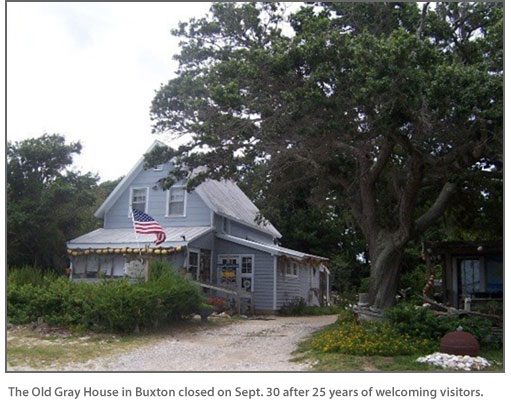As I sit in Buxton, and rock on the front porch of the home of my grandparents, Bill and Melissa Farrow Gray, I look across at what used to be called the Dark Ridge Road (now named the Light Plant Road), at the wire jungle of the Cape Hatteras Electric Membership Corporation.
I ask myself, why must everything change? Why is it that our beautiful Hatteras Island, in order to become a booming tourist attraction, has to have no semblance of the past? To become a part of the mainland world, do we have to give up our unique island heritage?
I was born in 1931 and spent my childhood days roaming the sand roads, soundside, and ocean beaches of the Buxton area. Those childhood days are locked forever in my memory. I still remember when there where few or no fences on the island, and children were free to play anywhere. I remember the sand roads, winding through the trees, and the vines running right to the top of the tallest tree. In fact, the vines were so dense that my buddy, Eldon Barnett, and I would run right up to the top of the trees on them.
Another fond memory is the dense pine straw on the Old Dark Ridge Path. That pine straw was so deep that we would swoop down the hillside on sleds made from cardboard that we acquired from Halloway Gray’s general store. As we became more knowledgeable, we changed from cardboard sleds to those made from barrel slats. With the help of my father and Elmore Gray, our barrel-slat, pine-straw sleds became so sophisticated they had seats and handles.
The Buxton Woods were a child’s paradise, full of excitement and pleasure. In those woods, we were able to walk freely to find treasures our elders had told us about, such as Indian pipes, wood that glowed in the dark, and gum from the gum trees. Mystery and excitement awaited us at every turn, not only in the Buxton Woods but at the sound and on the beach.
The Pamlico Sound and its surroundings provided us constant amazement. Our imaginations were kindled at the many new adventures we found there. One memorable adventure was the day we found a small Indian burial mound in the upper end of Buxton. Each little piece of pottery and flint gave way to visions of the day when the Indians roamed the island. Nature abounded in the sound area. The waters and banks were full of new adventures. Clams, oysters, crabs, fish, sting rays, eels, and birds — all taught us about this amazing world.
We learned early-on the rules of the island. You did not bother the other person’s property, such as boats, nets, or oyster beds. The code of the island was ingrained in all of us at an early age. We were taught to respect one another and to accept all people for what they were and not what they had, and most of all to keep our mouth shut about the other person’s business. There was no class system, for we were all in the same boat.
The beautiful beach was always there but never the same. With each rolling wave, there seemed to be something new to learn. What is this? What is that? Where did this come from? Wow! What wonders to behold! The little things, such as those black shiny objects with hooks on each end that wash up on the beach, brought questions that required answers.
I will always remember on my way home from the beach, while carrying a black shiny case, the response I got from Pearl Midgett, my Sunday School teacher, when I asked her what it was. After many cookies, I learned the legend of the devil’s pocketbook. To this day, I still call those black shiny objects with hooks or horns on them the devil’s pocketbook. I now know they are the skate’s egg case.
One of the wonderful things about being a child back then was that everybody took time to answer our questions. It was as if you were everybody’s child and everybody on the island was interested in you and protected you. I could walk from the beach to my home at the middle of Buxton on the front road, and by the time I got there my stomach was full from cake, cookies, and pie from the kitchens of every house I passed. I can still hear Chloe Barnett yelling, as I walked the Old Ridge Road past her house (where Fox Watersports is now located), “Whoo, woo, Sonny, honey, come in here.” Every house had a hug and something to eat waiting for you.
My childhood daytime activities on Hatteras were happy hours full of excitement and adventure. Even though we had no television and few toys except those we created, we never seemed to have a boring moment. The evenings were probably my most treasured memories. They were a time for reflections of the present and past happenings. We gathered with friend and family in the old home place or in the general store.
There seemed to be an unwritten agenda for these informal gatherings. First, the islanders shared the most recent news of the day, then they joked a little with each other, always mindful of not hurting each other’s feelings. My father contributed to the daily agenda, sharing news he heard as he delivered block ice to the kitchens of the homes on the island. By this time darkness began to set in, and the islanders continued their daily ritual by gathering around the wood-burning stove or near the oil lamp.
As the oil lamp began to flicker or the fire leaped out from the wood burner, they seemed to be led to their last and most enjoyable portion of the evening. One by one, they shared tales from the past, often confusing fact from fiction. Now, as I look back, I realize much of their enjoyment came from knowing their audience of little heads nodding in the dark was listening in amazement and awe at the gruesome, as well as the wonderful, tales of the island.
One tale they repeated occasionally, I am sure, was for my benefit. It was the story about the oak tree in the bend of the sand road between my home and Mr. Frank Miller’s house. As they told it, there were people who had walked in the shadow of the mighty oak who had disappeared in broad daylight. I can remember running barefoot in the hot sand around that mighty oak, being sure that its shadow did not touch me. There was no way I wanted to end up being a branch on an oak tree for the rest of my life. It did not hurt my feelings one bit when they cut that tree down for Highway 12. I heard later that you could hear the screams from the branches all the way to Manteo as they put the saw to that mighty oak.
Tale time was also marked by short intervals of silence, as the islanders stared at the light as if they were reliving the bygone days and just basking in the enjoyment of being together. It was in these moments that I realized they were all wealthy people because they had everything. They had each other.
At the appointed time, the evening gathering just seemed to dissipate and another joyful day on Hatteras Island was soon to close. Hatteras kids would lay their heads down on pillows of feathers and fly away to the happy land of make believe to awaken to another day of adventure and excitement.
My 1930’s recollections of Hatteras are fond memories that not only bring me joy but also sorrow. It is sad to realize that no longer will the future generations be able to appreciate freely the beauties of our island as I did as a child. It has rightly been said, “One of the most important legacies we can provide our children and for future generations is the gift of knowledge about the family’s heritage and surroundings.”
The woods, sound, and beach are not only becoming less accessible because of fences and new rules and regulations that also reflect man’s interference with the forces of nature. The trees and vine coverings are disappearing at an alarming rate, along with the old homeplaces that not only stood as monuments to the past but also marked the unique characteristics of the island. The names of the roads and even the villages no longer reflect the past or the presence of the people who originally settled on Hatteras. For real-estate reasons, not only have roads been abandoned or eliminated, but many old cemeteries have disappeared, along with the memories of the founding fathers of the island.
The older you get, the more you realize change is inevitable. Your choices are limited as to what you can do about it. The good old days on Hatteras are gone forever, and no matter how much we want them back, we cannot make it happen. The best we can hope for is that each person who loves the Outer Banks will resolve to be a committee of one, dedicated to the preservation of the past, and appoint himself as a protector of the environment for the future. We also need to equip our young people with a knowledge of their rich family heritage and a zeal for preserving the unique island history.
As I rock and look at the asphalt road, covering the sand road that wound through the trees to the school house, I still cannot help but wonder why they thought changing the name of the road from Dark Ridge Road to Light Plant Road was a mark of progress.




